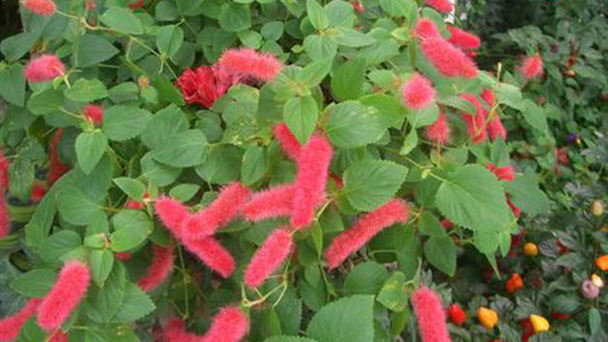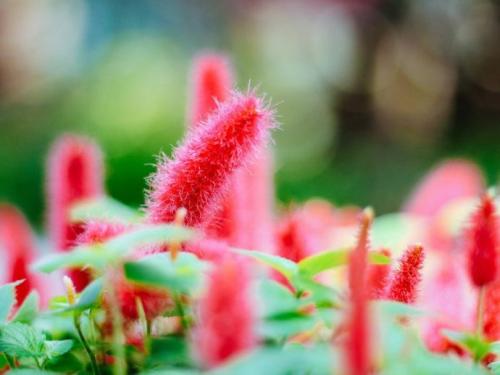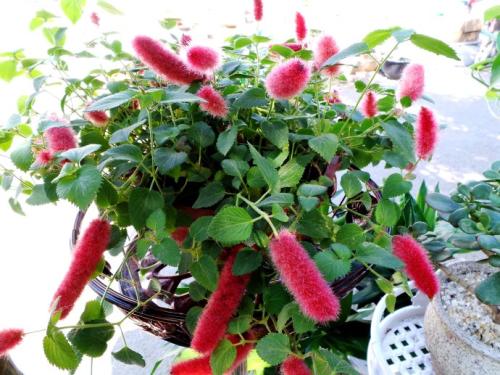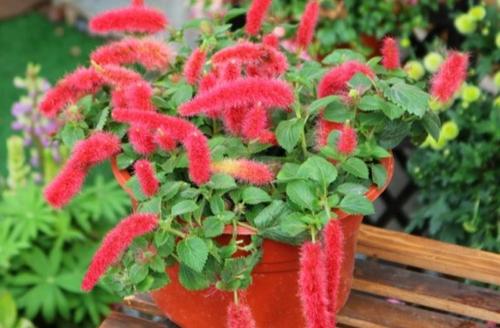Dwarf Chenille (Acalypha reptans) profile
Written by Maggie
Mar 25 2021

Dwarf Chenille (Acalypha reptans) is an evergreen shrub belonging to the genus Amaranth of Euphorbiaceae, with branches of semi-tendrils and plant height of 10 cm to 25 cm. Dwarf Chenille can grow on the ground prostrate, and is overhanging if cultivated in hanging pots.
Dwarf chenille picture

Morphological characteristics of dwarf chenille
Dwarf Chenille is an evergreen shrub belonging to the genus Amaranth of Euphorbiaceae, with branches of semi-tendrils and plant height of 10 cm to 25 cm. It can grow on the ground prostrate, and is overhanging if cultivated in hanging pots. Leaves are alternate, ovate, apex acute, leaf margin serrate, hairy on both surfaces.
Dwarf Chenille had a natural flowering period of spring to autumn and it could bloom all year round in the human cultivated environment.
Dwarf Chenille flowers in summer and fall.
Ecological habits of dwarf chenille
Dwarf Chenille prefers warm, wet and sunny conditions. But not cold, in northern China is usually a greenhouse potted flower cultivation.
Dwarf Chenille likes fertile soil, and the overwintering temperature should be above 18℃. If the temperature is below 12℃, the leaves will droop. If the temperature is low for a long time, the leaves will fall off.
How to grow and care for dwarf chenille
Light: Bright indirect light in summer; 4 hours direct sun per day in winter. Plants won't bloom without lots of sunlight.
Water: Keep soil evenly moist. Do not let it dry out. Give dwarf chenille plenty of water in summer. It's a good idea to check the soil moisture every 2-3 days when the plant is growing and blooming. Reduce water during the winter months, when growth is slower.
Humidity: Aim to maintain moderate to high, 50-60% relative humidity year-round. It's a good idea to use a humidity monitor rather than guess. Closed-up homes and central heating can make indoor air extremely dry in winter. The most efficient way to boost humidity for tropical plants is to use a cool-mist room humidifier.
Temperature: Average to warm 65-85°F/18-29°C year-round
Soil: Good-quality, all-purpose potting mix.
Fertilizer: Feed every 2 weeks spring and summer with a high-phosphorus liquid fertilizer diluted by half.
The way Dwarf Chenille propagtes
Cuttings are commonly used in Dwarf Chenille and are easily rooting in spring. Pay attention to fertilizing during the growing season.
Dwarf plant breeding can be combined in a basin of Chenille points, also can undertake cutting, shearing in spring season first robust branches, also can be in May to June collection was born healthy and full of branches as cuttings, cut each into 10 to 15 cm, to keep the top 2 to 3 pieces, remove the lower blade, inserted in the pure sand or vermiculite stone, pour enough water, avoid sun exposure, keep moist soil, air, after in not less than 20 ℃ environment, about 30 to 40 days.

Classification of dwarf chenille species
The main colors of Dwarf Chenille are purple, red, and pink.
The distribution of dwarf chenille
Dwarf Chenille is native to New Guinea and other Central America and the West Indies, and is widely cultivated all over the world.
Function of dwarf chenille
Potted role
The Dwarf Chenille inflorescences are brightly colored and very pleasing. dwarf chenille is suitable for flower bed beautification, hanging pot planting or ground cover.
The economic value
Dwarf chenille has a natural blooming period of spring to autumn and can bloom all year round in the artificial cultivated environment. The female flowers are short spikes and have fluffy luster, bright red and resemble dog tail and red caterpillar. It is called "Suishui (Suizhou) Rou" by businessmen, and it means "Suishui" and "Suishui".
Garden use of dwarf chenille
Dwarf Chenille is ideal for parks, botanical gardens, and yards.

Latest Updated
- Benefits of Bugleweed - 7 Science-backed Health Benefits
- Bugleweed Dangers & Side Effects - Is It Poisonous?
- How to Plant Evergreen Trees - What You Should Know
- When to Plant Evergreens - Grow Guide for Evergreen Trees
- 12 Wonderful Evergreen Shrubs for Your Garden
- 12 Popular Evergreen Plants with Pictures for Beginners
- When And How To Prune A Lilac Bush Like a Pro
- How to Grow & Care for Lilac Vine (Hardenbergia Violacea)
- Japanese Lilac Tree (Syringa Reticulata) Care & Propagation Guide
- Shumard Oak Pros and Cons - What to Know
Popular Articles
- Winter maintenance of Antirrhinum Majus
- How to Grow Terminalia Mantaly Tree
- How to Grow and Care for Crossostephium Chinense
- How to grow Antirrhinum Majus in spring
- Peristeria Elata (Dove Orchid) Profile: Info & Care Guide
- Underwatered Snake Plant (Sansevieria Trifasciata) - Signs And How To Fix
- How to Care for Brazilian Jasmine Plant (Mandevilla Sanderi)
- How to Grow & Care for Graptopetalum Purple Delight in Summer
- Rosa Chinensis (China Rose): Plant Growing & Care Tips
- How to Care for Baby Sun Rose (Aptenia Cordifolia)